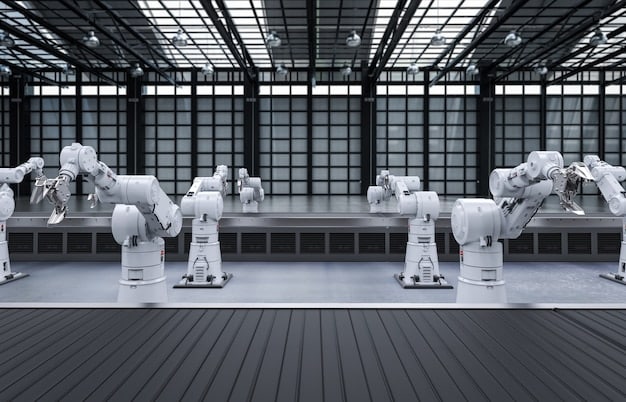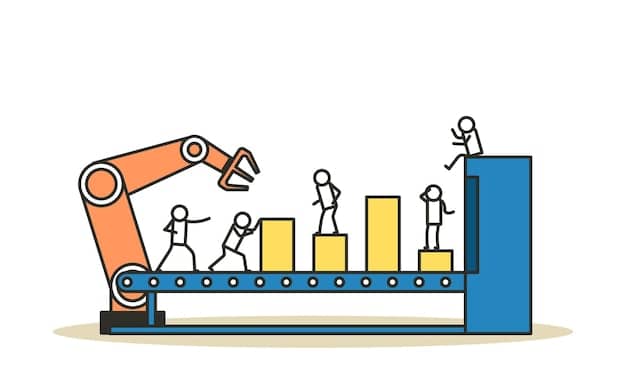Automation’s Impact: Reshaping the US Job Market with Technology

Automation’s impact on the US job market is significant, as technology advancements lead to shifts in required skills, job displacement in some sectors, and the creation of new opportunities in others, necessitating workforce adaptation and retraining.
The rise of automation and technological advancements is rapidly transforming the US job market. The impact of automation: how technological advancements are reshaping the US job market, is a multifaceted issue, presenting both challenges and opportunities for workers and businesses alike. Understanding these changes is crucial for navigating the future of work.
Automation and the Evolving US Job Market
Automation, driven by advancements in artificial intelligence, robotics, and machine learning, is no longer a futuristic concept. It’s a present reality reshaping industries across the United States. This technological revolution is impacting various sectors, from manufacturing to customer service, altering job roles and skill requirements.
The implications of automation extend beyond mere job displacement. It’s about redefining work, demanding new skills, and creating new opportunities that didn’t exist before. Businesses are increasingly adopting automated systems to enhance efficiency, reduce costs, and improve productivity, leading to a fundamental shift in the labor landscape.

Key Drivers of Automation
Several factors are fueling the rapid adoption of automation in the US job market. These drivers include technological advancements, economic pressures, and the increasing need for efficiency and productivity.
- Technological Breakthroughs: Advances in AI, robotics, and machine learning have made automation more accessible and cost-effective for businesses.
- Economic Efficiency: Companies are seeking to reduce operational costs and improve profit margins through automation.
- Increased Productivity: Automated systems can operate 24/7, leading to higher output and reduced downtime.
- Data Analysis: The need to process large volumes of data efficiently is driving the adoption of automation in data-intensive industries.
In conclusion, automation’s impact on the US job market is driven by a combination of technological progress and economic incentives. These factors are reshaping industries and altering the demand for specific skills, requiring workers and businesses to adapt to the changing landscape.
Industries Most Affected by Automation
While automation is impacting nearly every industry, some sectors are experiencing more profound changes than others. Understanding which industries are most vulnerable to automation is crucial for preparing the workforce for future challenges and opportunities.
Industries like manufacturing, transportation, and customer service are at the forefront of this transformation. The increasing use of robots in factories, self-driving vehicles, and AI-powered customer support systems is significantly altering traditional job roles.
Manufacturing and Automation
Manufacturing has long been a pioneer in adopting automation technologies. Robots and automated systems are now commonplace in factories, performing tasks such as assembly, welding, and packaging. This has led to increased efficiency and reduced labor costs, but also significant job displacement for low-skilled workers.
Transportation and Logistics
The transportation and logistics industries are on the cusp of a major transformation with the advent of self-driving vehicles. While widespread adoption is still years away, the potential impact on jobs in trucking, delivery, and warehousing is significant.
- Trucking: Self-driving trucks could reduce the demand for human drivers, impacting a large segment of the workforce.
- Delivery Services: Drones and autonomous delivery vehicles are poised to revolutionize last-mile delivery, potentially displacing traditional jobs.
- Warehousing: Automated systems and robots are increasingly being used in warehouses to improve efficiency and reduce labor costs.
In essence, the industries most affected by automation are those where repetitive tasks and manual labor are prevalent. While automation offers increased efficiency and productivity, it also necessitates workforce retraining and adaptation to mitigate potential job losses.
The Skills Gap and the Need for Retraining
One of the most significant challenges posed by automation is the widening skills gap. As technology advances, the demand for workers with specific technical skills is growing, while the need for those with traditional manual skills is declining.
Addressing this skills gap is crucial for ensuring that workers can adapt to the changing job market. Retraining and upskilling programs are essential for equipping individuals with the skills needed to succeed in an automated world.

Strategies for Retraining and Upskilling
Several strategies can be implemented to address the skills gap and facilitate workforce adaptation. These strategies include government initiatives, industry partnerships, and individual efforts.
- Government Programs: Investing in education and training programs that focus on in-demand skills, such as coding, data analysis, and robotics.
- Industry Partnerships: Encouraging collaboration between businesses and educational institutions to develop training programs that align with industry needs.
- Online Learning Platforms: Leveraging online learning platforms to provide accessible and affordable training opportunities for workers.
- Apprenticeships: Promoting apprenticeship programs that combine on-the-job training with classroom instruction.
In summary, bridging the skills gap requires a multifaceted approach involving government support, industry collaboration, and individual initiative. By investing in retraining and upskilling programs, the US can ensure that its workforce remains competitive in an increasingly automated world.
New Job Opportunities Created by Automation
While automation is often associated with job displacement, it also creates new job opportunities in emerging fields. Understanding these opportunities is crucial for guiding workforce development and ensuring that individuals can adapt to the changing job market.
The rise of automation is driving demand for professionals in areas such as AI development, data science, and robotics engineering. These new roles require specialized skills and knowledge, but they offer significant growth potential.
Emerging Fields and Job Roles
Automation is not only reshaping existing industries but also creating entirely new fields and job roles. These emerging areas offer exciting opportunities for individuals with the right skills and training.
Examples of new job opportunities include:
- AI Developers: Creating and maintaining artificial intelligence systems and algorithms.
- Data Scientists: Analyzing large datasets to identify trends and insights that can inform business decisions.
- Robotics Engineers: Designing, building, and maintaining robots and automated systems.
- Automation Specialists: Implementing and managing automation solutions in various industries.
In short, automation is fostering the creation of new job opportunities that require specialized skills and expertise. By focusing on education and training in these emerging fields, the US can equip its workforce with the tools needed to thrive in the future of work.
The Role of Government and Policy
Government policies and regulations play a crucial role in shaping the impact of automation on the US job market. Policymakers must address the challenges of job displacement while fostering innovation and economic growth.
Effective government initiatives can help mitigate the negative effects of automation by providing support for displaced workers, investing in retraining programs, and promoting inclusive economic growth.
### Policy Recommendations for the Automation Era
To effectively navigate the challenges and opportunities presented by automation, policymakers should consider the following recommendations:
Policy Recommendations include:
- Invest in Education: Increase funding for education and training programs that focus on in-demand skills.
- Support Displaced Workers: Provide unemployment benefits, job placement services, and retraining opportunities for workers displaced by automation.
- Promote Innovation: Encourage innovation and technological advancement through research and development grants and tax incentives.
In conclusion, government policies and regulations are essential for managing the impact of automation on the US job market. By investing in education, supporting displaced workers, and promoting innovation, policymakers can help ensure that the benefits of automation are shared broadly.
Preparing for the Future of Work
The future of work is being shaped by automation and technological advancements, presenting both challenges and opportunities for individuals and businesses. Preparing for this new landscape requires proactive strategies and a willingness to adapt.
Individuals must embrace lifelong learning, acquire new skills, and be open to changing career paths. Businesses must invest in retraining programs, foster a culture of innovation, and prioritize employee well-being.
Strategies for Individuals and Businesses
To thrive in the future of work, individuals and businesses should adopt the following strategies:
These strategies include:
- Lifelong Learning: Commit to continuous learning and skill development to stay relevant in a rapidly changing job market.
- Adaptability: Be open to new roles and responsibilities, and be willing to adjust career paths as needed.
- Collaboration: Foster collaboration between humans and machines, leveraging the strengths of both.
By embracing these strategies, individuals and businesses can navigate the challenges of automation and seize the opportunities presented by the future of work.
| Key Point | Brief Description |
|---|---|
| 🤖 Automation’s Impact | Reshaping industries and job roles significantly. |
| 🏭 Affected Industries | Manufacturing, transportation, and customer service. |
| 🧑🎓 Skills Gap | Growing need for technical skills, retraining essential. |
| 💼 New Opportunities | AI, data science, and robotics are creating jobs. |
Frequently Asked Questions
▼
Automation’s primary effect involves shifting job landscapes, requiring workers to adapt to new roles and acquire different skills to stay competitive as technology advances.
▼
Industries like manufacturing, transportation, and customer service face significant job losses due to automating repetitive tasks using robotic systems and AI.
▼
Skills in high demand include data analysis, AI development, robotics engineering, and adaptability, alongside critical thinking and creative problem-solving capabilities.
▼
Governments can provide unemployment benefits, skills training, and job placement services, to help displaced workers transition to new opportunities in the job market.
▼
Businesses should invest in employee retraining, create a company culture that encourages innovation, and utilize technology in a manner that supplements rather than replaces human labor.
Conclusion
In conclusion, the impact of automation on the US job market is profound and multifaceted. While automation presents challenges such as job displacement and the need for retraining, it also creates new opportunities in emerging fields. By embracing lifelong learning, investing in education, and fostering a culture of innovation, the US can navigate the complexities of automation and ensure that its workforce remains competitive in the future of work.